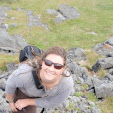So, to save ourselves some agony and trouble of hauling gear, we asked the caballero who frequents this little shanty house near our study site if we could use some space in the stable. He agreed, but what I have now realized is that this came with a price. Two tomahawks have gone missing, and now the scissors Tina lent me (so sorry, Tina!), along with some vials we were using to store samples, tape and I am sure something else that has no immediate consequence to our work, but will sorely be missed when I really need it... whatever it is.
Leaving the equipment in the field may be a better option, but I fear now that the Chilean mentality about some things might strip us down to nearly nothing by the last week if I am not careful. Little of the equipment I am using really belongs to me, so I am understandably worried about this. However, I carry the expensive, irreplaceable things back to the cabin with me each day, so we won’t be crippled if the tomahawk box disappears.
On a high note, I saw some Andean geese today, which was very cool. Pablo and I only trapped one coruro in Colony C (3), which was probably for the best because of the theft of our vials. It left some time for speaking Spanglish and getting to know Pablo, who kindly stepped in to take Claudia’s place. He completed his degree in Marine Biology at a university in Conceptión, the city closest to the epicenter of the earthquake this past February. Pablo showed me a typo in the field guide I’ve been using. The small wild cat that lives in the south of Chile is called by many names in the field guide 'A Wildlife Guide to Chile: Continental Chile, Chilean Antarctica, Easter Island, Juan Fernandez Archipelago', but the meaning of the primarily used name in the book means something different than is intended and is not the correct spelling. The actual name of the cat is guiña. I expect I should write a letter to the author, Sharon Chester, and let her know about the necessary change in the second edition.
Some personal reflection on the research also went on, which included some work on the mental ‘to do’ list. I find it hard to get much accomplished in the afternoons, as the hike back to the cabin tends to be rather exhausting, and chores, cooking and eating need to get done. It doesn’t leave much time for working on data analysis or keeping up with sample labels. It will kick me in the tush later, but maintaining my health is most important. I cannot afford to have the flu a third time this field season.


No comments:
Post a Comment